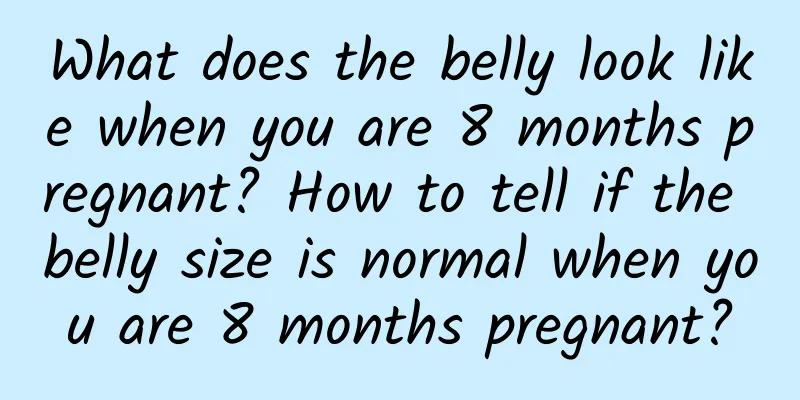What does the belly look like when you are 8 months pregnant? How to tell if the belly size is normal when you are 8 months pregnant?

|
We all know that after a woman becomes pregnant, her belly will gradually grow. Because each pregnant mother has a different physique, their belly is also different. Some pregnant mothers have a bigger belly, while some pregnant mothers have a smaller belly. So what does a belly look like when you are 8 months pregnant? Let's take a closer look! What does an 8 month pregnant belly look like?At 8 months of pregnancy, which is about 32 weeks, although the belly is already visible, the shape of each expectant mother's belly looks different. Some expectant mothers have a belly that tilts forward and appears pointed, while some have a round belly, and some even have a hanging belly. Every expectant mother's belly shape is different, so how can we judge whether the size of the belly is normal? In fact, every time the expectant mother goes for a prenatal check-up, the doctor will measure the expectant mother's abdominal circumference. As long as the abdominal circumference is within the normal range, it is a normal phenomenon. Of course, the abdominal circumference standards are different every month. Generally, if there are any abnormalities, the doctor will inform the expectant mother in time, so there is no need to worry too much. In short, the shape of each expectant mother's belly may be different during the 8th month of pregnancy, some may be big, some may be small, some may be pointed, and some may be round, but as long as the prenatal examination is normal, the expectant mother does not need to worry too much. How to judge whether the belly shape is normalSince the belly shape is different, how to judge whether the pregnancy belly is normal? It is very simple. The abdominal circumference of pregnant women of different months is different. Every time you go for a prenatal check-up, you have to measure the uterine height and abdominal circumference. The uterine height refers to the height of the uterus, and the abdominal circumference refers to the length of the abdomen. These two data are used to measure the size of the uterus. Generally, the uterine height and abdominal circumference are measured starting from the 20th week of pregnancy: At 20 weeks, the uterine height is between 15.3 and 21.4 cm, and the abdominal circumference is between 76 and 89 cm At 24 weeks, the uterine height is between 22 and 25.1 cm, and the abdominal circumference is between 80 and 91 cm At 28 weeks, the uterine height is between 22.4 and 29 cm, and the abdominal circumference is between 82 and 94 cm At 32 weeks, the uterine height is between 25.3 and 32 cm, and the abdominal circumference is between 84 and 95 cm At 36 weeks, the uterine height is between 29.8 and 34.5 cm, and the abdominal circumference is between 86 and 98 cm. 40 weeks, uterine height is about 33 cm, abdominal circumference is between 89-100 cm Abdominal circumference and uterine height will be considered in conjunction with the weight gain of the pregnant woman. The weight gain of each pregnant woman is different, so the above data is only for reference. The size of the pregnant belly is related to several factors1. Fetal sizeBy the eighth month of pregnancy, the fetus weighs about 2000g. In fact, not every fetus is this weight. Some pregnant mothers eat well, have adequate nutrition, and get good rest. The fetus absorbs well and has an ideal weight. If the pregnant mother often eats high-sugar and high-calorie foods, the weight of the fetus may even exceed this weight. It is a truly giant baby. However, some pregnant mothers will be affected by pregnancy reactions, have poor appetite, and be picky about food, which will result in the fetus not getting enough nutrition. The fetus' weight is not ideal and may be light. The size of the fetus directly affects the size of the pregnant belly. 2. Amniotic fluid volumeThe normal amount of amniotic fluid is generally 300-2000ml, and it is different in each stage of pregnancy. At the eighth month of pregnancy, the amount of amniotic fluid is generally 1000-1500ml, but not every pregnant mother has the same amount of amniotic fluid. Obviously, the belly will appear larger if there is more amniotic fluid, and the belly will appear smaller if there is less amniotic fluid. 3. The height of the pregnant motherIf the pregnant mother is tall and thin, under the same conditions, her belly will generally be smaller. If the pregnant mother is short and fat, even if the fetus is not very big, her own flesh (abdominal fat) will already occupy a certain space, making it difficult for her belly not to be bigger. 4. Position of pregnancyThe position of the fetus will also affect the size of the pregnant belly. For example, if the fetus is carried in the upper or lower part of the womb, the placenta is located on the front wall or the back wall. If the fetus is carried in the upper part of the womb and the placenta is attached to the back wall, the pregnant mother's belly will not be that big. If the pregnant mother is carried in the lower part of the womb and the placenta is attached to the front wall, the belly will appear larger. 5. Number of fetusesThere is nothing much to say about this. Normally, the belly of twins or multiple babies should be bigger than that of a single baby. If it is a special case, there is nothing to discuss. |
Recommend
Which parts of the body can identify pregnancy?
After getting married, people usually put pregnan...
Can a fetus with rhabdomyomas give birth?
Generally speaking, most fetal rhabdomyomas are b...
Unveiling the secrets of lung cancer: From symptom identification to precise treatment, read it in one article!
Author: Zhi Xiuyi, Chief Physician of Beijing Tsi...
Naked-eye 3D vision test pictures are trending on the Internet, and many ophthalmologists are called out by netizens hoping to get professional responses
Recently, a set of naked-eye 3D vision test pictu...
Will leucorrhea cause lower back pain?
Leucorrhea is a common symptom among women. Under...
Female buttocks pain
We all know that the pace of life of urban people...
The correct way to stop nosebleeds, 90% of people may do it wrong
Recently, the weather in Guangzhou seems to have ...
Fallopian tube blockage surgery cost
According to doctors, fallopian tube blockage is ...
How many days after pregnancy can you use the early pregnancy test paper to detect
How many days of pregnancy can be detected with a...
What is the best medicine for women with iron deficiency?
Iron is an essential trace element in human life....
What does it mean for a woman to have no uterus?
Any normal female friend is unwilling to have a h...
Can I have sex when my period is almost over?
We all know that women cannot have sex during men...
Will I lose weight if my endocrine system is regulated?
It is very troublesome for women to have endocrin...
Women can quickly enhance their physical fitness by using this method!
How can women improve their physique? Everyone kn...
Benefits of Cervical Dilation Balloon
We all know that natural childbirth is the best w...









